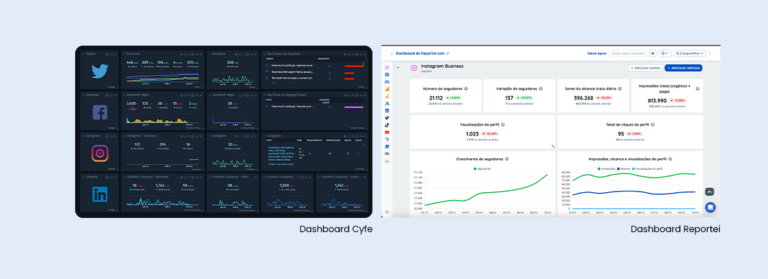Check out the step-by-step guide on how to write an effective report conclusion and practical examples for inspiration
Writing an effective conclusion for a report makes all the difference when presenting results, justifying investments, and guiding future actions.
After all, it is in this section that you can convey credibility, professionalism, and clearly outline the next steps for the client.
Therefore, in this article, we’ve selected the best tips to help you structure your report conclusion, with practical examples for different types of strategies – from social media to e-commerce and inbound marketing. Keep reading!
The Importance of a Strong Conclusion in a Marketing Report
The conclusion of a report should not be limited to a simple phrase stating that “everything went well” or that “the results were satisfactory.”
On the contrary, it is in the conclusion that the real value of all the work done throughout the analyzed period is highlighted. In fact, a well-structured text helps to:
- Emphasize results: By summarizing data and insights, you clearly show what was achieved. This way, everyone involved can understand where growth occurred, which goals were met, and where improvement is needed;
- Justify investments: One of the biggest concerns of clients or managers is understanding whether the resources were applied efficiently. Therefore, when reaching the conclusion, it’s essential to indicate whether the money spent generated a return and what the main achievements were;
- Guide the next steps: The decision to maintain a campaign, change strategies, or reallocate the budget depends on the results presented. Thus, if the conclusion clearly outlines what needs to be done, the team can act with much more confidence and agility;
- Demonstrate professionalism: When the team or analyst delivers a clear, cohesive, and contextualized report conclusion, it instills confidence in the client, manager, or stakeholder involved – reinforcing the image of seriousness and expertise on the subject.
As we can see, the conclusion is not just a formal closing, but a moment to highlight everything that has been done.
Therefore, each part of the report – from metric analysis to presenting specific results – should “speak” to the conclusion, making it solid and well-founded.
Step-by-step guide to creating an effective conclusion
To create an impactful report conclusion, it is important to follow some basic steps, which can be adapted to your specific context. Here are the key ones:
1. Revisit the initial objectives
First and foremost, remind yourself of the goals and purpose of the project. For example, if the campaign aimed to increase e-commerce sales or improve Instagram engagement, provide a brief summary of this at the beginning.
This step helps the reader recall the starting point and understand the context when reaching the conclusion of the report.
2. Present the main results
After revisiting the objectives, focus on the most relevant results. There’s no need to repeat all the metrics already shown, but rather highlight those that are most relevant to the report’s theme.
For example, mention the increase in conversions, reduction in cost per click, or growth in the number of leads generated.
3. Analyze impacts and lessons learned
A good report conclusion is one that not only lists numbers but also interprets the data and highlights what was learned.
In this way, you demonstrate an analytical perspective that is capable of turning metrics into practical knowledge.
4. Propose improvements and next steps
After identifying what worked and what needs adjustment, suggest concrete actions for the future.
It could be testing a new audience segmentation on Google Ads, increasing investment in social media content, or even changing the website layout. In fact, this part of the conclusion is crucial to show that you are committed to continuous improvement.
5. Use clear and direct language
Avoid overly technical terms or long sentences. A conclusion that is simple and objective has much more impact, especially when it is sent to audiences who are not specialists in digital marketing.
Also, remember to adjust the tone to the profile of the report’s recipient: if it’s an executive team, for example, be more concise. On the other hand, if it’s an internal marketing team, you can provide more detail on the strategies.
6. Adapt to the report format
Each report format (social media, paid traffic, inbound marketing, etc.) may require a different structure.
Therefore, the way to conclude the report can also vary. It’s crucial to tailor the report conclusion according to the nature of the campaign, highlighting strategic points that are relevant to that specific context.
Examples of conclusions for different reports
Now that you know the step-by-step process for concluding reports effectively, it’s also worth checking out practical examples that can serve as inspiration to present results in your conclusions:
Conclusion for a Social Media Report
“During the analyzed period, we were able to increase engagement on Instagram posts by 40%, rising from an average of 200 to 280 interactions per post. This reinforces the effectiveness of the new content strategy, which focused on topics more relevant to the target audience.
For the next quarter, we suggest intensifying the influencer partnership and maintaining the posting frequency, as both have proven effective in gaining new followers.”
In this example of a report conclusion, it is clear that the objective – increasing engagement – was achieved. It then outlines a path to maintain and improve this performance.
Conclusion for a Paid Traffic Report
“The investment in Google Ads resulted in a 25% increase in leads, with a 10% reduction in cost per lead compared to the previous period. The A/B tests with keywords and creatives were key to the positive result.
As the next step, we recommend increasing the budget for the campaign with the highest conversion rate (Campaign X) and testing new ad variations to expand reach.”
In this suggestion, it’s important to note that the results are correlated with lead acquisition goals, and there is a clear recommendation on where to allocate more resources.
Conclusion for an E-commerce Report
“In the last month, the e-commerce conversion rate increased from 2.5% to 3.2%, totaling a 28% growth. The checkout optimizer implemented reduced the cart abandonment rate by 15%.
For the next period, we propose testing a more streamlined mobile layout and strengthening remarketing campaigns to boost repeat purchases.”
With a conclusion like this, you emphasize the increase in conversions and provide practical insights, such as investing in mobile to further improve results.
Conclusion for an Inbound Marketing Report
“In this quarter, inbound marketing generated 500 new qualified leads, representing a 35% growth compared to the previous period. The email automation was responsible for 30% of the conversions, highlighting the importance of personalized workflows.
We recommend further segmenting the contact database, creating content paths tailored to each stage of the funnel.
Additionally, producing blog articles focused on long-tail keywords proved effective in attracting organic visitors to the site, making it important to continue this strategy.”
Finally, this conclusion not only demonstrates the effectiveness of email workflows but also reinforces the need for continuous personalization and segmentation, which are key pillars of inbound marketing.
Automate your reports with Reportei
Creating comprehensive reports and drawing well-supported conclusions requires time and attention to detail. If you are still doing this process manually, you are probably spending hours collecting data, formatting information, and generating final analyses.
In this scenario, Reportei stands out as a solution to optimize your workflow and ensure that the conclusion of the report is done quickly, without sacrificing quality.
With Reportei, you no longer need to spend hours compiling metrics from various digital marketing platforms and formatting extensive documents. The tool allows you to:
- Centralize information from different marketing channels in one place, generating intelligent reports with just a few clicks;
- Create automated reports and receive them via email, saving even more time for analyzing data and developing the future project plan;
- Develop analyses with an AI tool, which helps you gain better insights and make more strategic decisions.
In other words, by automating much of the process, you free up time to focus on what really matters: planning for better results.
This way, your report conclusion stops being just a final section and becomes the bridge between what was done and what can still be improved.





